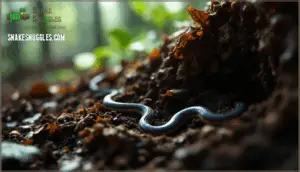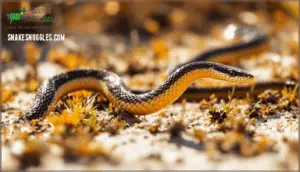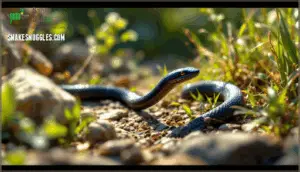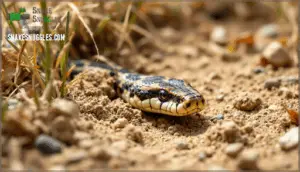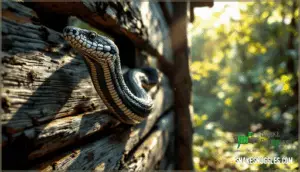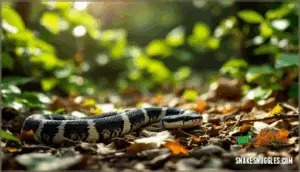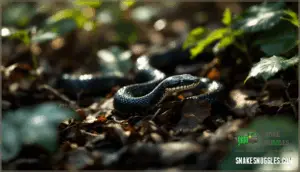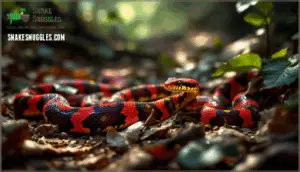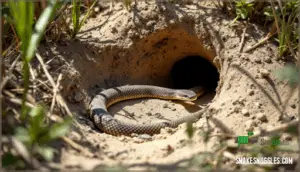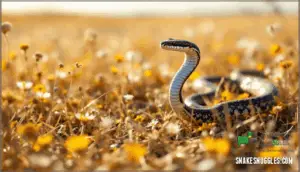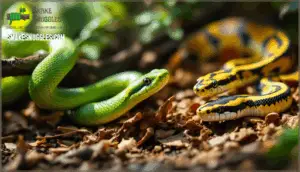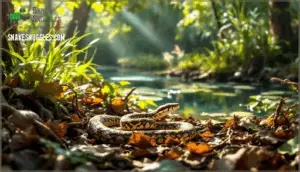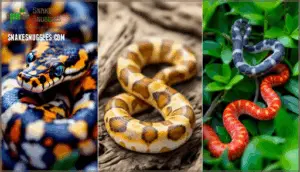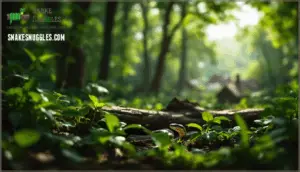This site is supported by our readers. We may earn a commission, at no cost to you, if you purchase through links.
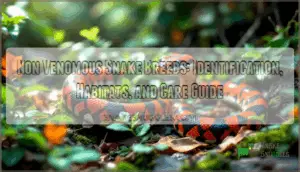 Most people think snakes with bright colors spell danger, but that’s not always the case. Non-venomous snake breeds often wear bold patterns as a survival tactic, mimicking their venomous cousins to scare off predators.
Most people think snakes with bright colors spell danger, but that’s not always the case. Non-venomous snake breeds often wear bold patterns as a survival tactic, mimicking their venomous cousins to scare off predators.
Across North America, dozens of harmless species slither through forests, grasslands, and wetlands, keeping rodent populations in check and maintaining balance in their ecosystems. These snakes don’t inject venom—they rely on constriction, speed, or clever theatrics to survive.
Learning to recognize them matters for your safety and theirs, especially as habitat loss pushes more species closer to human spaces. From the lightning-fast Black Racer to the drama-queen Eastern Hognose, each breed brings unique adaptations worth understanding.
Table Of Contents
- Key Takeaways
- Common Non Venomous Snake Breeds
- Distinctive Features and Behaviors
- Snake Habitats and Regional Distribution
- Rare and Unique Non Venomous Snakes
- Conservation and Human Interaction
- Frequently Asked Questions (FAQs)
- What is the most friendly non-venomous snake?
- Which is the most dangerous non-venomous snake?
- Is a python a non-venomous snake?
- Are there any non venomous snakes?
- Are non venomous snakes good pets?
- Are there venomous snakes in North America?
- Are smooth snakes venomous?
- Where do non venomous snakes live?
- Are snakes poisonous?
- What is the most non-venomous snake?
- Conclusion
Key Takeaways
- Non-venomous snakes control rodent populations and maintain ecosystem balance, with approximately 85% of snake bites occurring when humans attempt to kill or handle these beneficial reptiles rather than leaving them alone.
- Bright coloration in snakes doesn’t reliably indicate venom, as many harmless species use mimicry to resemble dangerous ones for protection, making accurate identification critical for both human safety and snake conservation.
- Habitat loss and human encroachment increasingly threaten non-venomous snake populations by causing fragmentation, reduced genetic diversity, and food scarcity, despite most species not being officially endangered.
- Different non-venomous species occupy distinct ecological niches across North America’s forests, grasslands, and wetlands, with specialized adaptations like climbing ability in Gray Ratsnakes or burrowing behavior in Worm Snakes that reflect their specific habitat requirements.
Common Non Venomous Snake Breeds
If you’re curious about which snakes you might spot in your backyard or local park, you’re in the right place. Each breed on this list has its own look and habits, making it easy to tell them apart.
Let’s take a closer look at some of the most common non venomous snakes you’ll find.
Worm Snake
If you’ve ever spotted a tiny, earthworm-like snake wriggling through leaf litter, chances are you’ve met the humble worm snake. It prefers moist, shaded habitats and spends most of its time burrowing underground.
Remember these four things:
- Quiet nature
- Secretive burrowing behavior
- Gentle survival tactics
- Essential role in soil health
Their presence signals a thriving ecosystem.
Eastern Coachwhip
Just a short distance from where worm snakes work their quiet magic beneath the leaves, the Eastern Coachwhip comes sprinting onto the scene—energetic, watchful, and strikingly fast.
This non-venomous snake is a master of Coachwhip Speed, using sharp vision and lightning-quick hunting strategies. Its regional variations create eye-catching color morphs, and its defensive behavior is memorable—bolting away rather than standing its ground.
Black Racer
As soon as the coachwhip is out of sight, you might catch a blur zipping by—the Black Racer, living up to its name with speed and attitude to match.
Black Racers thrive in sunny, open habitats, eagerly hunting insects and small animals. Fast reflexes and sharp eyesight guide their bold behavior, making them stand out in any talk about Snake Identification.
Eastern Hognose Snake
Next in line, you’ll spot the Eastern Hognose Snake—famous for its upturned nose and the dramatic show it puts on when startled. With hognose snakes, you’ll recognize:
- Upturned snout for digging in loose soil.
- Dramatic defense like playing dead.
- Mild, docile temperament in captivity.
- Stable conservation status—an adaptable member of non venomous snakes across varied snake habitats.
Gray Ratsnake
No stranger to climbing barns or slithering quietly through the woods, the Gray Ratsnake is a master of blending in and keeping pests in check. You’ll spot this non venomous snake by its checkered belly and dark body. Adaptable across regions, Gray Ratsnakes thrive in many snake habitats and are known for their calm temperament and impressive climbing ability.
| Identifying Features | Climbing Ability | Captive Care |
|---|---|---|
| Checkered belly | Excellent | Hardy, easy to feed |
| Dark gray to black | Tree climber | Needs hiding spots |
| Square body shape | Farm buildings | Stable temperament |
| Varies by region | Fence climber | Accepts frozen prey |
| Up to 6 feet long | Follows rodents | Regular cleaning |
Eastern Kingsnake
With its bold bands of black and creamy white, the Eastern Kingsnake makes an entrance wherever it goes. Known for tackling other snakes—including venomous ones—this nonvenomous species prefers forest edges, fields, or riverbanks.
Eastern Kingsnake care is straightforward: a secure, spacious habitat suits them well, and their diet specifics include rodents, reptiles, and eggs. Conservation concerns remain minimal, thanks to their adaptability.
Black Kingsnake
Picture a snake with glossy black scales and a quiet confidence slithering through the underbrush—that’s the Black Kingsnake. Known for Melanism genetics, this Kingsnake often reflects regional subspecies differences.
In captivity, captive breeding shapes temperament variations. Hybridization risks are a concern, but Black Kingsnakes thrive in diverse snake habitats and distribution regions, standing out among nonvenomous snake species.
Scarlet Kingsnake
Ever notice a snake that looks like it’s dressed for a parade, all decked out in red, black, and yellow rings? That’s the Scarlet Kingsnake—famous for its Scarlet mimicry. Regional variations exist, making Snake Identification tricky. Watch for these clues:
- NonVenomous Snakes
- Scarlet mimicry bands
- Identifying look-alikes
- Conservation concerns
- Captive care tips
Mole Kingsnake
If you’ve ever wondered about the shy snake that spends more time underground than above it, the mole kingsnake is a master of hiding in plain sight. Known for its secretive behavior and subterranean lifestyle, this kingsnake favors sandy or loose soils where it hunts small rodents.
Good to know for reptile identification: their subtle patterns help them blend, making them a challenge to spot.
Prairie Kingsnake
You’re just as likely to spot a prairie kingsnake weaving its way through open fields as you are to miss it completely, thanks to its knack for vanishing into grassy habitats. Regarding non-venomous snake species, this kingsnake stands out for:
- Habitat preference: open grasslands
- Diet specifics: rodents and frogs
- Regional variations in markings
- Captive care is straightforward
Distinctive Features and Behaviors
Every non-venomous snake has its own way of standing out, whether it’s color, size, or the way it lives. You’ll find some prefer the trees, while others stick to the ground and keep to themselves.
Let’s look closer at what makes each breed unique.
Size Variations Among Breeds
Every non-venomous snake breed in the wild brings its own size to the table, from slender little species you might almost miss to hefty, muscular constrictors that leave a bigger impression.
Maximum lengths and average weights can vary widely—even within the same snake species.
Growth rates also depend on animal adaptation, and some show sexual dimorphism or reach true size extremes, aiding species identification.
Color Patterns and Markings
Just as non-venomous snakes come in all shapes and sizes, their color patterns and markings can turn an ordinary encounter into something memorable.
Pattern variation, influenced by genetic basis and regional differences, helps these non-venomous snake species blend in or stand out.
From camouflage techniques to mimicry markings, understanding snake species and characteristics is essential for species identification and any reliable snake ID guide.
Defensive Mechanisms
Beyond their eye-catching patterns, these snakes have a few clever tricks up their sleeves to protect themselves when trouble comes calling. Non venomous snake species often rely on mimicry, playing dead, musking, or even tail autotomy. Some create hissing sounds or flatten their bodies.
Knowing these snake behaviors helps you understand snake safety and the variety of snake species and characteristics.
Diet and Feeding Habits
It’s no secret that Non Venomous Snake Species come with a variety of tastes. Whether it’s insects, frogs, or small mammals, their Prey Selection says a lot about Reptile Biology and Ecology. Some hunt by ambush, others by active pursuit.
Feeding Frequency and Dietary Needs shift by Snake Species—those in captivity require careful attention to safe, diverse Captive Diets. Many of these snakes use constriction, a method where they squeeze their prey until it dies.
Arboreal Vs. Terrestrial Lifestyles
While some snakes make their home among the branches, others keep close to the ground, each style of living shaping how these reptiles look and behave. Climbing Adaptations—like a prehensile tail or longer body—help arboreal snakes move through trees.
Terrestrial snakes favor Ground Hunting and unique Locomotion Styles, all influenced by their Habitat Preference and specific Predation Risks tied to Snake Behavior and Diet.
Snake Habitats and Regional Distribution
Snakes live in a range of habitats, from thick forests to open grasslands and lively wetlands. You’ll find different species scattered across North America and in unique regions like the Big Thicket.
Let’s take a look at some of the most common places these non-venomous snakes call home.
Forest, Grassland, and Wetland Habitats
Picture the untamed edges of a forest or the quiet stretch of a marsh, and you’ll find all sorts of non-venomous snakes making themselves right at home in these surprisingly diverse habitats.
- Forest canopies shelter arboreal species.
- Grasslands host terrestrial snakes with camouflaged patterns.
- Wetlands support skilled aquatic snakes.
- Each habitat shapes unique behavior and diet.
- Human impact and conservation challenges influence habitat preservation, directly affecting regional snakes.
North American Snake Distribution
Across North America, you can spot a striking range of non-venomous snake species, from the grasslands of Texas to wetlands in Florida. Changing habitat preferences and population trends highlight how animal adaptation shapes where snakes thrive.
Range limits and even extirpation events remind you of the delicate balance between species diversity and habitat and ecosystem preservation.
Some states, like Alaska and Hawaii, have no venomous snakes due to geographic and climate conditions.
Snakes of The Big Thicket Region
Tucked away in southeast Texas, the Big Thicket feels like a living museum—where winding trails take you right into the habitat of some of the region’s most fascinating non-venomous snakes.
Big Thicket National Preserve showcases habitat diversity, making Thicket Snake ID a real adventure. Regional snake diet and behavior can shift here, shaped by unique conservation challenges and ongoing human impact.
Adaptation to Local Ecosystems
Ever notice how some snakes seem tailor-made for their surroundings, blending in or standing out just enough to thrive where they live? Habitat specificity and animal adaptation and evolution are at play.
Regional variations—like differences in prey availability or climatic adaptations—drive changes in reptile ecology and behavior, letting nonvenomous snake species form symbiotic relationships within ecological systems, even amidst habitat loss.
Rare and Unique Non Venomous Snakes
Some non-venomous snakes stand out for their unusual looks or rare genetics. These unique snakes can be especially fascinating to learn about or spot in the wild.
Here are some of the rare and striking types you might encounter.
Wild White Snake Genetics
Think a white snake is rare as a blue moon? In the habitat of NonVenomous Snake Species, wild white individuals are an example of Genetic Diversity and fascinating Color Mutations. Exploring their origins involves:
- Leucism Genetics research
- Albinism Inheritance studies
- Breeding Impact on populations
- Reptile Taxonomy within Animal Biology
Snake Identification and Safety relies on understanding these nuances.
Leucism and Albinism
If you’ve ever spotted a snake that looked almost ghostly white or washed-out, you’ve probably glimpsed the effects of leucism or albinism in action. These genetic mutations affect pigment absence in reptiles, creating visually striking leucistic snakes or albino snakes. Differences in appearance shape snake identification and safety, while pigment changes influence snake behavior and habitat.
| Type | Pigment Loss | Visual Challenges |
|---|---|---|
| Leucistic | Partial | Some camouflage loss |
| Albino | Complete | Sensitive to light |
| Normal | None | Typical camouflage |
Palmetto Corn Snake
Just when you think you’ve seen every twist on snake coloration, the Palmetto corn snake steps onto the scene with its white scales dusted in confetti-like spots. This unique morph owes its look to Palmetto genetics—distinct from the classic Red Cornsnake.
Breeding specifics are essential for maintaining these nonvenomous snakes, whose husbandry needs differ from typical varieties, highlighting the importance of snake identification and safety.
Super Phantom Reticulated Python
After marveling at the Palmetto corn snake’s confetti-dappled pattern, it’s hard not to be amazed by the Super Phantom reticulated python, a breed that seems to blur the line between natural beauty and something out of a dream.
Born from Super Phantom genetics, these nonvenomous pythons in the python family stand out for dramatic morphs and variations—alluring, but with unique captive care needs and breeding challenges for keepers.
Coral Snow Corn Snake
The Coral Snow corn snake brings a splash of soft pinks and whites that make it look every bit as enchanting as the rarest pythons in the snake world.
Created through careful Coral Snow genetics, this color morph is sought after for its gentle looks and manageable husbandry needs.
Proper species identification and understanding its breeding challenges help guarantee healthy, thriving nonvenomous snakes.
Conservation and Human Interaction
Non-venomous snakes don’t just live alongside us—they actively shape the health of our ecosystems and deserve our understanding. However, habitat loss and human activity increasingly threaten these beneficial species.
Let’s explore how you can help protect these snakes while safely sharing space with them.
Role in Ecosystem Balance
Non-venomous snakes work as nature’s pest control crew, keeping rodent populations in check and preventing the spread of disease throughout their habitats. Their role in ecosystem health extends beyond prey population control:
- Support biodiversity by maintaining ecological balance
- Contribute to nutrient cycling through decomposition
- Aid seed dispersal when consuming small mammals
- Serve as food for larger predators
- Indicate overall wildlife ecology status
Understanding snake conservation helps you appreciate their importance to animal diversity and classification within your local environment.
Impact of Habitat Loss
As forests shrink and wetlands disappear, habitat loss triggers population decline and species displacement among non-venomous snakes. Food scarcity increases when prey disappears, while fragmentation reduces genetic diversity within isolated populations.
This environmental impact on snakes creates ecosystem imbalance, threatening biodiversity and ecological balance.
Wildlife conservation and snake conservation efforts address these challenges to maintain healthy populations.
Coexisting Safely With Snakes
You can share your yard with snakes without drama—if you know what to look for and how to respond when paths cross. Preventing snake encounters starts with keeping grass trimmed and removing debris piles where snakes hide. If you spot one, safe snake removal means keeping your distance and calling wildlife professionals. Pet safety requires supervision outdoors, while educational outreach programs teach families snakebite first aid and proper identification.
- Keep woodpiles, rock piles, and tall grass away from high-traffic areas
- Learn to identify local non-venomous species through environmental education resources
- Teach children to observe snakes from a distance, supporting wildlife conservation and ecology awareness
Conservation Status and Efforts
Most non-venomous snakes aren’t threatened or endangered, but habitat preservation remains critical. Global assessments track population health, while threat identification helps target recovery programs.
Wildlife conservation and management efforts address trade impacts and protect vulnerable species. Reptile conservation initiatives monitor snake conservation status to prevent further decline.
You can support these efforts by protecting local habitats and participating in environmental education programs.
Importance of Snake Identification
Knowing whether a snake is venomous or harmless can literally save your life—and theirs. Misidentification consequences lead to unnecessary killing of beneficial species, while venomous look-alikes confuse even experienced observers. Accurate identification benefits everyone through reduced fear and better coexistence.
Public education improves wildlife awareness:
- Snake classification training helps you distinguish safe species from dangerous ones
- Species identification and classification reduces harmful encounters
- Understanding identification challenges prevents misidentification consequences
Frequently Asked Questions (FAQs)
What is the most friendly non-venomous snake?
Corn snakes consistently rank as the most friendly non-venomous species. Their calm temperament traits and ease in captivity make them ideal for those prioritizing interaction safety and breed docility during holding frequency with snakes.
Which is the most dangerous non-venomous snake?
Large constricting snakes like reticulated pythons and boa constrictors pose the greatest risks. Their constriction dangers can cause serious injury or death.
Management risks increase with size, though aggression levels vary by species and individual temperament.
Is a python a non-venomous snake?
Pythons belong to the python family within the Animal Kingdom and use constriction rather than venom to subdue prey. Unlike members of the boa family, pythons are completely non-venomous.
These constricting snakes inhabit diverse Python Habitats across tropical regions, feeding on mammals and birds as part of their Python Diet.
Are there any non venomous snakes?
Thousands of snake species exist worldwide, and most belong to harmless groups. In fact, the vast majority of snakes lack venom entirely.
The colubrid family, boa family, and python family all contain non-venomous members, dispelling common snake misconceptions about these reptiles.
Are non venomous snakes good pets?
Many species make excellent pets if you’re prepared for their enclosure needs and interaction concerns. Snake temperament varies by species, but beginner species like corn snakes adapt well to captivity.
Ethical considerations include supporting animal welfare and reptile conservation through responsible ownership, not wild capture.
Are there venomous snakes in North America?
Yes, North America is home to several venomous snakes. Copperheads, cottonmouths, coral snakes, and various rattlesnake species inhabit different regions across the continent.
Proper venomous snake ID and understanding regional venomous species distribution helps you stay safe outdoors and seek appropriate snakebite treatment if needed.
Are smooth snakes venomous?
Contrary to old wives’ tales about "milk snakes" stealing from dairy farms, smooth snakes are completely non-venomous.
Snake misidentification is common with the Eastern Smooth Earth Snake and Western Smooth Earth Snake, harmless species often confused with venomous lookalikes in herpetology circles.
Where do non venomous snakes live?
Depending on species, snakes inhabit forests, grasslands, wetlands, deserts, and aquatic environments across diverse geographic ranges. Climate influence and habitat specificity determine distribution, while microhabitats provide shelter. You’ll find aquatic and terrestrial snakes adapting to local ecosystems worldwide.
Are snakes poisonous?
Snakes aren’t poisonous, but some are venomous. Venom injects through fangs during a bite, while poison must be ingested.
Understanding this difference matters for wildlife education and awareness. Recognizing venomous snakes helps you respond appropriately to snakebite symptoms and apply proper first aid.
What is the most non-venomous snake?
There’s no single "most" non-venomous snake, since thousands of species worldwide lack venom entirely. Defining non-venomous snakes involves herpetological research and species identification to confirm the absence of venom glands.
Temperament differences and interaction difficulty vary widely across snake diversity and classification. Beginner snakes like corn snakes pose minimal bite severity compared to larger constrictors, though all require proper care to avoid defensive strikes.
Conclusion
Nearly 85% of snake bites happen when people try to kill or touch the reptile—proof that fear often creates the danger we’re trying to avoid. Understanding non-venomous snake breeds transforms that fear into respect.
These harmless species control pests, stabilize food webs, and remind us that boldness doesn’t equal threat. Next time you spot a colorful serpent in your backyard, take a breath before reacting.
Learning the difference between mimicry and menace might just save a life—theirs and yours.
- https://www.peta.org/issues/animal-companion-issues/pet-trade/
- https://www.crittercontrol.com/wildlife/snakes/types-of-snakes/
- https://a-z-animals.com/animals/snake/snake-facts/snake-population-state/
- https://www.worldatlas.com/animals/why-some-us-states-have-no-venomous-snakes.html
- https://www.trailquest.net/SNnonpoi.html

